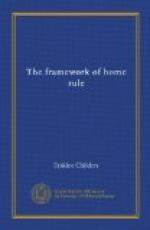Queen banished for adultery, lived in England or abroad
upon incomes drawn from the impoverished Irish Exchequer.
Nor was it only a question of pensions. Quantities
of valuable sinecure offices were habitually given
to Englishmen who never came near the shores of Ireland.
In short, the English policy towards Ireland was similar
to Spain’s policy towards her South American
Colonies, minus the grosser forms of physical cruelty
and oppression. Yet Ireland, like the American
Colonies until the verge of the revolutionary struggle,
was consistently loyal to the Crown both in peace
and war. The loyalty of Catholic Ireland, poverty-stricken,
inarticulate, almost leaderless, and shamefully misgoverned,
does not, from the human standpoint, appear worthy
of admiration, but it was a fact. The few Catholic
noblemen outdid the Protestants in expressions of
devotion; the Whiteboy risings were as little disloyal
as religious. Not a hand stirred for James or
his heirs when Jacobite plots and risings were causing
grave public danger in England and Scotland. Catholic
Lord Trimleston offered exclusively Catholic regiments
with Catholic officers to George III. for foreign
service in 1762, though they were vetoed by what his
Viceroy Halifax called the “ill-bred bigotry”
of the Irish Parliament. Nor was it till thirty
years after that date that Protestant discontent,
under intolerable provocation, assumed an anti-dynastic
and Republican form. To compare the Imperial
spirit displayed by America and Ireland in their views
and action is difficult, partly because the various
American Colonies differed widely, partly because there
existed in Ireland no organ of government which could
express popular feeling. Neither country, of
course, paid any cash contribution to Imperial expenses,
though both could fairly claim that the English monopoly
of trade imposed an indirect tribute of indefinite
size, while Ireland, in pensions, rents to absentees,
and sinecure appointments, was drained of many millions
more. American patronage was an element of substantial
value to England, but it was not on the Irish scale.
America on the whole, perhaps, showed less patriotic
feeling than Ireland. With full allowance for
the lack of sympathy and understanding shown by the
British regulars to the American volunteers in their
co-operation in the French wars, it can scarcely be
denied that the colonists, together with much heroism
and public spirit, showed occasional slackness and
parsimony in resisting the penetration of a foreign
Power which threatened to hem in their settlements
from the St. Lawrence to the mouth of the Mississippi.
Ireland during the Seven Years’ War, and until
the Peace of Paris in 1763, maintained a war establishment
of 24,000 troops. She maintained a peace establishment
of 12,000 troops, and from 1767 onwards of 15,000
troops. There never seems to have been a whisper
of protest from the Catholic population against these
measures, nor, except in the matter of the American
War, to which we shall come presently, from the Protestants.
It may be added that, after 1767, Catholics in considerable
numbers were surreptitiously enlisted in the ranks,
in spite of the Penal Code, and from then until the
present day have fought for the Flag as staunchly
as any other class of the King’s subjects.




